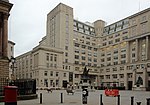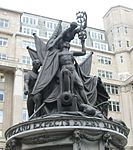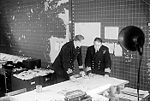Liverpool is a city and metropolitan borough in Merseyside, England. With a population of 498,042 in 2019, it is the tenth largest English district by population and its metropolitan area is the fifth largest in the United Kingdom, with a population of 2.24 million.On the eastern side of the Mersey Estuary, Liverpool historically lay within the ancient hundred of West Derby in the county of Lancashire. It became a borough in 1207, a city in 1880, and a county borough independent of the newly-created Lancashire County Council in 1889. Its growth as a major port was paralleled by the expansion of the city throughout the Industrial Revolution. Along with general cargo, freight and raw materials such as coal and cotton, merchants were involved in the slave trade. In the 19th century, Liverpool was a major port of departure for English and Irish emigrants to North America. It was also home to both the Cunard and White Star Lines, and was the port of registry of the ocean liners RMS Titanic, RMS Lusitania, RMS Queen Mary and RMS Olympic.
In 2019, Liverpool was the fifth most visited UK city. It is noted for its culture, architecture and transport links. The city is closely associated with the arts, especially music; the popularity of the Beatles, widely regarded as the most influential band of all time, led to it becoming a tourist destination. Liverpool has continued to be the home of numerous notable musicians and record labels—musicians from the city have released 56 No. 1 hit singles, more than any other city in the world. The city also has a long-standing reputation for producing countless actors and actresses, artists, athletes, comedians, journalists, novelists and poets. Liverpool has the second highest number of art galleries, national museums, listed buildings and listed parks in the UK; only the capital, London, has more. The former Liverpool Maritime Mercantile City includes the Pier Head, Albert Dock and William Brown Street. In sport, the city is best known for being the home of Premier League football teams Liverpool FC and Everton FC, with matches between the two rivals being known as the Merseyside derby. The annual Grand National horse race takes place at Aintree Racecourse.
Several areas of Liverpool city centre carried World Heritage Site status from 2004 until 2021; the city's vast collection of parks and open spaces has been described as the "most important in the country" by England's Register of Historic Parks and Gardens of Special Historic Interest. Its status as a port city historically attracted a diverse population from a wide range of cultures, primarily Ireland, Norway and Wales. It is also home to the oldest black community in the UK and the oldest Chinese community in Europe. Natives of Liverpool, and some longtime residents, are formally referred to as Liverpudlians but are more often called Scousers in reference to Scouse, a local stew made popular by sailors in the city, which is also the most common name for the local accent and dialect. The city celebrated its 800th anniversary in 2007 and was named the 2008 European Capital of Culture, which it shared with the Norwegian city of Stavanger, and its status as the European Capital of Culture has been credited with kickstarting its economic renaissance.












